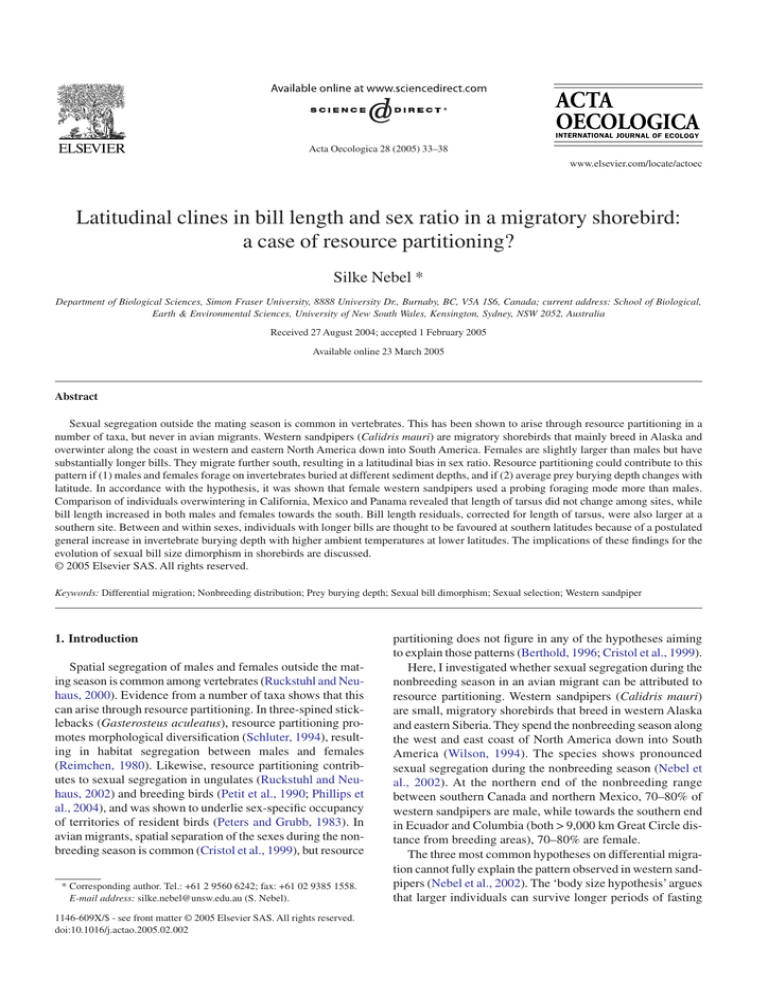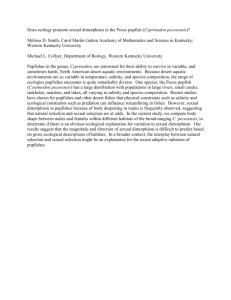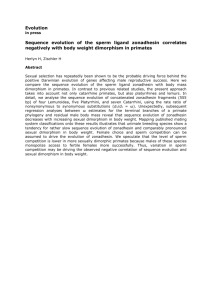Latitudinal clines in bill length and sex ratio in a... a case of resource partitioning?
advertisement

Acta Oecologica 28 (2005) 33–38 www.elsevier.com/locate/actoec Latitudinal clines in bill length and sex ratio in a migratory shorebird: a case of resource partitioning? Silke Nebel * Department of Biological Sciences, Simon Fraser University, 8888 University Dr., Burnaby, BC, V5A 1S6, Canada; current address: School of Biological, Earth & Environmental Sciences, University of New South Wales, Kensington, Sydney, NSW 2052, Australia Received 27 August 2004; accepted 1 February 2005 Available online 23 March 2005 Abstract Sexual segregation outside the mating season is common in vertebrates. This has been shown to arise through resource partitioning in a number of taxa, but never in avian migrants. Western sandpipers (Calidris mauri) are migratory shorebirds that mainly breed in Alaska and overwinter along the coast in western and eastern North America down into South America. Females are slightly larger than males but have substantially longer bills. They migrate further south, resulting in a latitudinal bias in sex ratio. Resource partitioning could contribute to this pattern if (1) males and females forage on invertebrates buried at different sediment depths, and if (2) average prey burying depth changes with latitude. In accordance with the hypothesis, it was shown that female western sandpipers used a probing foraging mode more than males. Comparison of individuals overwintering in California, Mexico and Panama revealed that length of tarsus did not change among sites, while bill length increased in both males and females towards the south. Bill length residuals, corrected for length of tarsus, were also larger at a southern site. Between and within sexes, individuals with longer bills are thought to be favoured at southern latitudes because of a postulated general increase in invertebrate burying depth with higher ambient temperatures at lower latitudes. The implications of these findings for the evolution of sexual bill size dimorphism in shorebirds are discussed. © 2005 Elsevier SAS. All rights reserved. Keywords: Differential migration; Nonbreeding distribution; Prey burying depth; Sexual bill dimorphism; Sexual selection; Western sandpiper 1. Introduction Spatial segregation of males and females outside the mating season is common among vertebrates (Ruckstuhl and Neuhaus, 2000). Evidence from a number of taxa shows that this can arise through resource partitioning. In three-spined sticklebacks (Gasterosteus aculeatus), resource partitioning promotes morphological diversification (Schluter, 1994), resulting in habitat segregation between males and females (Reimchen, 1980). Likewise, resource partitioning contributes to sexual segregation in ungulates (Ruckstuhl and Neuhaus, 2002) and breeding birds (Petit et al., 1990; Phillips et al., 2004), and was shown to underlie sex-specific occupancy of territories of resident birds (Peters and Grubb, 1983). In avian migrants, spatial separation of the sexes during the nonbreeding season is common (Cristol et al., 1999), but resource * Corresponding author. Tel.: +61 2 9560 6242; fax: +61 02 9385 1558. E-mail address: silke.nebel@unsw.edu.au (S. Nebel). 1146-609X/$ - see front matter © 2005 Elsevier SAS. All rights reserved. doi:10.1016/j.actao.2005.02.002 partitioning does not figure in any of the hypotheses aiming to explain those patterns (Berthold, 1996; Cristol et al., 1999). Here, I investigated whether sexual segregation during the nonbreeding season in an avian migrant can be attributed to resource partitioning. Western sandpipers (Calidris mauri) are small, migratory shorebirds that breed in western Alaska and eastern Siberia. They spend the nonbreeding season along the west and east coast of North America down into South America (Wilson, 1994). The species shows pronounced sexual segregation during the nonbreeding season (Nebel et al., 2002). At the northern end of the nonbreeding range between southern Canada and northern Mexico, 70–80% of western sandpipers are male, while towards the southern end in Ecuador and Columbia (both > 9,000 km Great Circle distance from breeding areas), 70–80% are female. The three most common hypotheses on differential migration cannot fully explain the pattern observed in western sandpipers (Nebel et al., 2002). The ‘body size hypothesis’ argues that larger individuals can survive longer periods of fasting 34 S. Nebel / Acta Oecologica 28 (2005) 33–38 and are therefore better suited to survive the colder and less predictable climates at higher latitudes (Ketterson and Nolan, 1976). In western sandpipers, however, members of the larger sex, females, winter further south. Alternatively, dominant individuals may monopolize areas closer to the breeding grounds to lower migration costs (Gauthreaux, 1978). Assuming that the larger sex dominates the smaller sex, one expects higher proportions of females at more northern sites, which is the opposite of the pattern observed in western sandpipers. However, the assumed dominance hierarchy remains to be verified with behavioural data of nonbreeding western sandpipers, which are currently unavailable. Finally, the ‘arrival time hypothesis’ predicts that members of the sex benefiting more from earlier arrival on the breeding grounds winter further north (Ketterson and Nolan, 1976; Myers, 1981). Male western sandpipers establish territories and arrive on the breeding grounds before the females (Holmes, 1971; Warnock and Bishop, 1998), and winter further north, which is in accordance with this hypothesis. However, western sandpipers wintering in central Mexico initiate northward migration 2–3 weeks earlier than those in central California (Fernández et al., 2001), suggesting that individuals are able to offset the longer migration distance by departing earlier (Nebel et al., 2002). Recently, it was shown that differential vulnerability to predation contributes to spatial segregation of males and females in western sandpipers (Nebel 2003). Escape performance in birds is reduced by extra body mass, as it leads to a decrease in take-off speed and manoeuvrability (Witter et al., 1994; Lind et al., 1999; Kullberg et al., 2000). In western sandpipers, wing loading decreased towards southern latitudes, while the abundance of predators remained constant. Females had higher wing loading than males and were thought to seek safety by wintering at southern latitudes, where less fat is carried (Nebel and Ydenberg, 2005). The predation risk hypothesis is consistent with the pattern observed in western sandpipers, but does not exclude the possibility that other variables also contribute to the striking cline in sex ratio. Sexual segregation in western sandpipers could arise through resource partitioning, if (1) males and females foraged on intertidal invertebrates buried at different depths, and if (2) average prey burying depth changed with latitude. Resource partitioning has been associated with differences in body size (Wilson, 1975), bill length (Suhonen and Kuitunen, 1991; Temeles et al., 2000), and feeding behaviour (Baker and Baker, 1973). In western sandpipers, females are only slightly (ca. 3%) larger than males, while the female bill is on average about 10% longer than the male bill (Cartar, 1984). Western Sandpipers employ probing (feeding on deeply buried prey) and pecking (feeding off the surface) as their two main modes of foraging (Sutherland et al., 2000). Whether nonbreeding female western sandpipers generally differ in their use of foraging mode from males is not known. Two testable predictions follow from the hypothesis that resource partitioning underlies sexual segregation of male and female western sandpipers, which, if upheld by the data, pro- vide a candidate explanation for the latitudinal cline in sex ratio in this species. First, if a sexual difference in resource use exists, it is predicted to be reflected by differences in foraging behaviour between males and females foraging at the same site. The difference in bill length alone does not necessarily result in resource partitioning, if both males and females were mainly using the pecking foraging mode. Secondly, if a latitudinal change in average prey burying depth occurs, one would predict a latitudinal increase in bill length within each sex from north to south. 2. Materials and methods 2.1. Data collected To document changes of morphometric variables across sites, birds were caught with mistnets, measured according to standard procedures, and aged (’adult’ or ’first-year’) according to plumage characteristics (Prater et al., 1977). Individuals with an exposed culmen of < 24.3 mm were classified as males, and > 24.7 mm as females (Page and Fearis, 1971). Individuals with intermediate bill length were not included in the analyses. A previous comparison of western sandpipers overwintering in Mexico, Panama, and Ecuador documented an increase in bill length towards the more southern sites (O’Hara (2002)). Bill length, however, correlates with overall body size. Using the residual increase in bill length therefore provides a more powerful test as to whether bill length or body size underlies the latitudinal sex ratio cline. Therefore, residuals from the regression analysis of bill length on tarsus length were compared among sites. Tarsus was used as an indicator of body size as opposed to wing, as wing length can be reduced by wear. In Mexico, some of the morphometric measurements were taken by a second observer, but no inter-observer variation was detected. In foraging individuals, bill length, and thus sex, was assessed noninvasively using a spotting scope (Kowa 20–60×), a technique that was highly accurate as assessed by an a priori trial (Nebel and Thompson, 2005). Based on whether individual birds inserted their bill to more than half of its length into the sediment, or fed off the surface, foraging behaviour was scored as a ‘probe’ or ‘peck’, respectively (Nebel and Thompson, 2005). 2.2. Study sites Data were collected at the following places and times: Tomales Bay, California, USA (39.2°N, 123.0°W, Nov.– Dec. 2000), Bodega Bay, California, USA (38.3°N, 123.0°W, Nov.–Dec. 2000), San Francisco Bay, California, USA (38.1°N, 122.3°W, Nov.–Dec. 2000), Bull Island, South Carolina, USA (32.8°N, 79.6°W, Dec. 2001), Bahía Santa María, Sinaloa, Mexico (24.0°N, 108.0°W, Jan.–Feb. 2000), Upper Bay of Panama, Republic of Panama (9.0°N, 79.3°W, Jan.– Feb. 2002), and Chitré, Herrera, Republic of Panama (8.1°N, S. Nebel / Acta Oecologica 28 (2005) 33–38 80.4°W, Feb. 2002). Data on foraging behavior were only collected at Bodega Bay, Bull Island, Upper Bay of Panama and Chitré. Morphometrics were measured at the Californian sites, at Bahía Santa María, Mexico, and at the Upper Bay of Panama, Republic of Panama. Data reported here are restricted to the period Nov.–Feb. in order to exclude recently arrived southward migrants, and individuals preparing for northward migration. 2.3. Statistical analysis Observations on foraging individuals were transformed into a score expressed as the proportion of probes: (number of probes/(number of pecks + number of probes)). This score was arcsine transformed prior to analysis to stabilize variance. All data were analysed using General Linear Models (GLM) in the statistical package Systat 11. (SYSTAT, Software Inc. 2004). Interaction terms were only reported when p > 0.05. 3. Results Female western sandpipers used the probing foraging mode more than males at all sites except California, where data on a single female only were collected (Fig. 1; Bodega Bay: F1,13 = 2.88, p = 0.11; Bull Island: F1,44 = 20.54, p < 0.001; Chitré: F1,53 = 10.21, p = 0.002; Panama Bay: F1,155 = 16.54, p < 0.001). In females, foraging score differed among sites (F3,166 = 5.28, p = 0.002), but not in males (F3,99 = 2.40, p = 0.07). In females, this effect appears to be attributable to the South Carolina data point, where the proportion of probes Fig. 1. Foraging score, expressed as proportion of probes ( ± 95% Confidence Interval), was higher in female (•—solid line) than in male (x—dashed line) western sandpipers. It did not differ among sites in males, while females probed most in South Carolina. Numbers of females (f) and males (m) observed at each site were as follows: California, USA: f = 1, m = 14; South Carolina, USA: f = 16, m = 30; Upper Panama Bay, Republic of Panama: f = 42, m = 114; Chitré, Panama Republic of Panama: f = 39, m = 16. 35 is high, but foraging behaviour is overall much more variable than at the other sites (Fig. 1). A pairwise comparison among sites, using the Bonferronie correction, showed that the only sites that differed in female foraging score were South Carolina and Upper Panama Bay (p = 0.004). A GLM testing for the effect of sex, age and site on bill length showed that female bills were significantly longer than male bills (F1,402 = 1251.11, p < 0.001), that bill length did not vary among age classes (F1,402 = 3.59, p = 0.059), but that it did change among sites (F2,402 = 10.82, p < 0.001; Fig. 2a). Pair-wise post-hoc analysis of site-differences, using the Bonferroni correction and taking into account the effect of sex and age, showed that bills were shorter in California than in Mexico (p < 0.001) and than in Panama (p = 0.003), while no significant difference was detected between Mexico and Panama (p = 1.00). Tarsus was larger in females than in males (F1,402 = 313.65, p < 0.001), did not vary among age classes (F1,402 = 3.84, p = 0.051), nor among sites (F2,402 = 0.90, p = 0.51; Fig. 2b). Bill length residuals corrected for length of tarsus were larger in females than in males (F1,402 = 157.00, p < 0.001), did not vary among age classes (F1,402 = 0.11, p = 0.74), but did change with site (F2,402 = 3.51, p = 0.031; Fig. 2c). Pair-wise post-hoc analysis of site-differences, using the Bonferroni correction and taking into account the effect of sex and age, showed that residuals were larger in Mexico than in California (p = 0.025), while no significant difference was detected between California and Panama (p = 0.26) nor Mexico and Panama (p = 1.00). 4. Discussion This study provided evidence that resource partitioning, at least partially, underlies spatial segregation of males and females in nonbreeding western sandpipers. The prediction that a sexual difference in foraging mode exists was upheld by the data, as females probed significantly more than males throughout the nonbreeding range. This pattern is consistent with sex-specific foraging behaviour observed on migratory stop-over sites (Mathot and Elner, 2004). Secondly, it was predicted that bill length increases towards more southern nonbreeding sites. Overall, this was found in both males and females, confirming an earlier report comparing western sandpipers from a more southern part of the nonbreeding range (O’Hara (2002)). However, no significant difference was found in bill length comparing individuals in Mexico and in Panama, which is most likely due to the small Panamanian sample (n = 62) in this study. Data presented by O’Hara (2002) contain 4829 individuals caught in Panama, allowing the detection of much smaller differences. Length of tarsus did not vary among sites, but residuals of bill length corrected for length of tarsus also tended to be larger at southern sites, suggesting that bill length rather than overall body size provides a selective advantage at southern latitudes. No difference in foraging score among sites was detected in males, while females used the probing foraging mode more 36 S. Nebel / Acta Oecologica 28 (2005) 33–38 Fig. 2. Length of bill (a), tarsus (b) and residual bill length, corrected for length of tarsus (c) ( ± 95% CI) of western sandpipers at three nonbreeding sites. See Results for statistical differences. Number of males (m) and females (f) at each site are as follows: California, USA: m = 41, f = 7; Sinaloa, Mexico: m = 243, f = 54, Upper Panama Bay, Republic of Panama: m = 27, f = 35. in South Carolina than in the Upper Bay of Panama. However, the sample of females observed in South Carolina was much smaller than at the two sites in Panama and variance in foraging behaviour was much higher. This raises the possibility that females, like males, do not significantly alter their foraging behaviour between sites, but more data are needed to provide a satisfactory answer. Having failed to detect a latitudinal trend in foraging behaviour may seem counterintuitive at first, but can likely be attributed to the increase in bill length towards southern sites. Even without adjusting their foraging mode towards more probing, individuals at southern latitudes can reach invertebrates buried at greater depth due to their longer bills. A possible explanation for the advantage of having a long bill at southern latitudes is provided by an observation made at a major tropical nonbreeding site, the Bay of Panama. Western sandpipers were observed to change their foraging mode with increasing sediment temperature from pecking on the surface towards probing for more deeply buried invertebrates (Nebel and Thompson, 2005). Intertidal invertebrates can increase burying depth in order to mitigate the detrimental effects of high temperatures and desiccation (Emson et al., 2002; Somero, 2002). The behavioural change observed in western sandpipers is thus interpreted to reflect a temperatureinduced increase in prey burying depth (Nebel and Thompson, 2005). Intertidal sediment temperature changes with ambient temperatures (Piccolo et al., 1993), which increase with proximity to the equator (Piersma et al., 2005). Invertebrates may therefore generally increase their burying depth towards lower latitudes. This could result in a latitudinal change in the relative availability of epi- versus in-faunal prey (Elner and Seaman, 2003; Nebel et al., 2005), creating an advantage for birds with longer bills (females), or a greater tendency to probe (females; Fig. 1) at equatorial sites. A latitudinal gradient in invertebrate burying depth remains to be empirically verified, but it potentially offers a novel and exciting explanation for the observed clines in bill length and sex ratio of western sandpipers, and possibly other species. The sexual differences in foraging behaviour reported here have potential implications for our understanding of the evolution of sexual bill size dimorphism in shorebirds. Most hypotheses regarding the evolution of sexual size dimorphism attribute it to either (1) sexual selection, or (2) resource partitioning (Hedrick and Temeles, 1989; Shine, 1989; Székely et al., 2000). Resource partitioning is, however, thought to be far less frequent than sexual selection as the cause of sexual dimorphism (Badyaev and Martin, 2000; Temeles et al., 2000). Based on comparative phylogenetic analyses, Székely et al. (2000,2004) conclude that sexual size dimorphism in shorebirds has evolved primarily due to sexual selection, as a smaller body facilitates aerial display during courtship (Jehl and Murray, 1986; Blomqvist et al., 1997). They did not find any evidence supporting the hypothesis that sexual bill dimorphism is caused by resource partitioning on the breeding grounds. However, many shorebirds are migratory, and spend most of the annual cycle away from the breeding grounds (Piersma, 1997), raising the possibility that selection on sexual bill dimorphism acts outside the breeding season. Resource partitioning as opposed to sexual selection as the agent of sexual dimorphism could also explain why sexual size dimorphism in bill length tends to be much more S. Nebel / Acta Oecologica 28 (2005) 33–38 pronounced than in any other structural character in this group (Jehl and Murray, 1986). The sexual selection scenario does not predict a shift in the relative size of the bill, unless its shape or size influences reproductive success (Shine, 1989). Assortative mating is generally rare in shorebirds (Wagner, 1999), and in western sandpipers, there is little evidence that sexual selection processes might be driving sexual size dimorphism (Sandercock, 1998,2001). According to Selander (1972), the only reliable evidence to infer natural selection as the cause of sexual dimorphism is a modification of the feeding structures. Namely, the degree of modification has to exceed what would be expected from body size differences alone, and has to be in a direction inconsistent with sexual selection. This has been documented in a few species only (Selander, 1966; Temeles et al., 2000). Moreover, Lande (1980) argued that in order to assign natural selection as the primary cause of sexual dimorphism, evidence for a sex-specific difference in the use of the dimorphic character also needs to be provided. In western sandpipers, the difference in bill length between males and females exceeds that in body size by far (Cartar, 1984; Jehl and Murray, 1986), and, as reported here, a sexual difference in foraging behaviour exists. Therefore, the criteria of both Selander (1972) and Lande (1980) are met, allowing the conclusion that sexual dimorphism in bill length in western sandpipers has been driven by resource partitioning during the nonbreeding season. 5. Conclusion I provided evidence supporting the hypothesis that in western sandpipers, resource partitioning contributes to the latitudinal clines in nonbreeding sex ratio as well as in bill length. Other hypotheses are also consistent with the sex ratio cline, but the resource partitioning hypothesis is the only one that also provides an explanation for the observed clines in bill length between as well as within sexes. A temperatureinduced cline in invertebrate burying depth is postulated, resulting in an advantage for birds with longer bills at southern sites. More empirical work is called for to support the notion of such a general cline in prey depth, but this hypothesis nevertheless offers a novel and potentially far-reaching explanation for the observed clines in bill length and sex ratio of western sandpipers. This study highlights the importance of resource partitioning in shaping animal distribution patterns, which has been recognized in a number of taxa, but has hitherto received no attention in the context of avian differential migration. Acknowledgements Brian McCaffery, Dov Lank, Patrik Nosil, Theunis Piersma, Danny Rogers, Nils Warnock, Tony D. Williams, Ron Ydenberg and Yuri Zharikov provided valuable com- 37 ments on the manuscript. I received logistical help from John Christy at Smithsonian Tropical Research Institute, Panama; Gilberto Salomon, Patolandia Hunting Club, Mexico; Craig Sasser at USFWS, Cape Romain NWR, South Carolina; Bodega Bay Marine Lab, California, and the Canadian Wildlife Service. Guillermo Fernandez facilitated fieldwork in Mexico. Cadi Schiffer, John Takekawa and Nils Warnock assisted with fieldwork in Bodega Bay, USA; Virgilio Antonio Pérez in Mexico; and Deborah Buehler at Panama Bay. Financial support was received from the Government of Canada, Sigma Xi, and the Centre for Wildlife Ecology at Simon Fraser University, Canada. References Badyaev, A.V., Martin, T.E., 2000. Sexual dimorphism in relation to current selection in the House Finch. Evolution Int. J. Org. Evolution 54, 987– 997. Baker, M.C., Baker, A.E.M., 1973. Niche relationships among six species of shorebirds on their wintering and breeding ranges. Ecol. Monogr. 43, 193–212. Berthold, P., 1996. Control of Bird Migration. Chapman & Hall, London. Blomqvist, D., Johansson, O.C., Unger, U., Larsson, M., Flodin, L.-Å., 1997. Male aerial display and reversed sexual size dimorphism in the dunlin. Anim. Behav. 54, 1291–1299. Cartar, R.V., 1984. A morphometric comparison of Western and Semipalmated Sandpipers. Wilson Bull. 96, 277–286. Cristol, D.A., Baker, M.B., Carbone, C., 1999. Differential migration revisited: latitudinal segregation by age and sex class. Curr. Ornithol. 15, 33–88. Elner, R.W., Seaman, D., 2003. Calidrid conservation: unrequited needs. Wader Study Group Bulletin 100, 30–34. Emson, R.H., Morritt, D., Andrews, E.B., Yound, C.M., 2002. Life on a hot dry beach: behavioural, physiological, and ultrastructural adaptations of the littorinid gastropod Cenchritis (Tectarius) muricatus. Mar. Biol. 140, 723–732. Fernández, G., de la Cueva, H., Warnock, N., 2001. Phenology and length of stay of transient and wintering western sandpipers at Estero Punta Banda, Mexico. J. Field Ornithol. 72, 509–520. Gauthreaux Jr., S.A., 1978. The ecological significance of behavioral dominance. In: Bateson, P.P.G., Klopfer, P.H. (Eds.), Perspectives in Ethology, vol 3. Plenum Publisher Corp, New York, pp. 17–54. Hedrick, A.V., Temeles, E.J., 1989. The evolution of sexual dimorphism in animals: hypotheses and tests. Trends Ecol. Evol. 4, 136–138. Holmes, R.T., 1971. Density, habitat, and the mating system of the Western Sandpiper (Calidris mauri). Oecologia 7, 191–208. Jehl Jr., J.R., Murray Jr., B.G., 1986. The evolution of normal and reverse sexual size dimorphism in shorebirds and other birds. Curr. Ornithol. 3, 1–86. Ketterson, E.D., Nolan Jr., V., 1976. Geographic variation and its climatic correlates in the sex ratio of eastern-wintering Dark-eyed Juncos (Junco hyemalis hyemalis). Ecology 57, 679–693. Kullberg, C., Jakobsson, S., Fransson, T., 2000. High migratory fuel loads impair predator evasion in Sedge Warblers. Auk 117, 1034–1038. Lande, R., 1980. Sexual dimorphism, sexual selection, and adaptation in polygenic characters. Evolution Int. J. Org. Evolution 34, 292–305. Lind, J., Fransson, T., Jakobsson, S., Kullberg, C., 1999. Reduced take-off ability in robins (Erithacus rubecula) due to migratory fuel load. Behav. Ecol. Sociobiol. 46, 65–70. Mathot, K.J., Elner, R.W., 2004. Evidence for sexual partitioning of foraging mode in Western Sandpipers (Calidris mauri) during migration. Can. J. Zool. 82, 1035–1042. 38 S. Nebel / Acta Oecologica 28 (2005) 33–38 Myers, J.P., 1981. A test of three hypotheses for latitudinal segregation of the sexes in wintering birds. Can. J. Zool. 59, 1527–1534. Nebel, S., Lank, D.B., O’Hara, P.D., Fernández, G., Haase, B., Delgado, F., et al., 2002. Western Sandpipers during the nonbreeding season: spatial segregation on a hemispheric scale. Auk 119, 922–928. Nebel, S., Jackson, D.L., Elner, R.W., 2005. Functional association of bill morphology and foraging behaviour in calidrid sandpipers. Anim. Biol. (in press). Nebel, S., Thompson, G.J., 2005. Foraging behaviour of Western Sandpipers changes with sediment temperature: implications for their hemispheric distribution. Ecol. Res. (in press) DOI: 10. 1007/s 11284-005-0061-x. Nebel, S., 2003. Factors underlying the nonbreeding distribution of Western Sandpipers. PhD Thesis. Simon Fraser University, Burnaby. O’Hara, P.D., 2002. The role of feather wear in alternative life history strategies of a long-distance migratory shorebird, the Western Sandpiper (Calidris mauri). PhD Thesis. Simon Fraser University, Burnaby. Page, G., Fearis, B., 1971. Sexing Western Sandpipers by bill length. Bird-Banding 42, 297–298. Peters, W.D., Grubb, T.C.J., 1983. An experimental analysis of sex-specific foraging in the Downy Woodpecker, Picoides pubescens. Ecology 64, 1437–1443. Petit, L.J., Petit, D.R., Petit, K.E., Fleming, W.J., 1990. Intersexual and temporal variation in foraging ecology of prothonotary warblers during the breeding season. Auk 107, 133–145. Phillips, R.A., Silk, J.R.D., Phalan, B., Catry, P., Croxall, J.P., 2004. Seasonal sexual segregation in two Thalassarche albatross species: competitive exclusion, reproductive role specialization or foraging niche divergence? Proc. R. Soc. Lond. B. Biol. Sci. 271, 1283–1291. Piccolo, M.C., Perillo, G.M.E., Daborn, G.R., 1993. Soil temperature variations on a tidal flat in Minas Basin, Bay of Fundy, Canada. Estuar. Coast. Shelf Sci. 35, 345–357. Piersma, T., 1997. The biology of migratory shorebirds. In: Straw, P. (Ed.), Shorebird Conservation in the Asia-Pacific Region. Australasian Wader Study Group of Birds Australia, Brisbane, Australia, pp. 2-12. Piersma, T., Rogers, D.I., González, P.M., Zwarts, L., Niles, L.J., de Lima Serrano do Nascimento, I., Minton, et al., 2005. Fuel storage rates in red knots worldwide: facing the severest ecological constraint in tropical intertidal conditions? In: Greenberg, R., Marra, P.P. (Eds.), Birds of Two Worlds: the Ecology and Evolution of Migratory Birds. Johns Hopkins University Press, Baltimore p xxx. Prater, T., Marchant, J., Vuorinen, J., 1977. Guide to the Identification and Ageing of Holarctic Waders. British Trust for Ornithology. Tring. Reimchen, T.E., 1980. Spine deficiency and polymorphism in a population of Gasterosteus aculeatus: an adaptation to predators? Can. J. Zool. 58, 1232–1244. Ruckstuhl, K.E., Neuhaus, P., 2000. Sexual segregation in ungulates: a new approach. Behaviour 137, 361–377. Ruckstuhl, K.E., Neuhaus, P., 2002. Sexual segregation in ungulates: a comparative test of three hypotheses. Biol. Rev. 77, 77–96. Sandercock, B.K., 1998. Assortative mating and sexual size dimorphism in Western and Semipalmated Sandpipers. Auk 115, 786–791. Sandercock, B.K., 2001. What is the relative importance of sexual selection and ecological processes in the evolution of sexual size dimorphism in monogamous shorebirds? Wader Study Group Bulletin 96, 64–70. Schluter, D., 1994. Experimental evidence that competition promotes divergence in adaptive radiation. Science 266, 798–801. Selander, R.K., 1966. Sexual dimorphism and differential niche utilization in birds. Condor 68, 113–151. Selander, R.K., 1972. Sexual Selection and Dimorphism in Birds. In: Campbell, B. (Ed.), Sexual Selection and the Descent of Man 1871–1971. Aldine Publishing Company, Chicago, pp. 180–230. Shine, R., 1989. Ecological causes for the evolution of sexual dimorphism: a review of the evidence. Q. Rev. Biol. 64, 419–461. Somero, G.N., 2002. Thermal physiology and vertical zonation of intertidal animals: optima, limits, and costs of living. Integr. Comp. Biol. 41, 780–789. Suhonen, J., Kuitunen, M., 1991. Intersexual foraging niche differentiation within the breeding pair in the Common Treecreeper Certhia familiaris. Ornis Scand. 22, 313–318. Sutherland, T.F., Shepherd, P.C.F., Elner, R.W., 2000. Predation on meiofaunal and macrofaunal invertebrates by western sandpipers (Calidris mauri): evidence for dual foraging modes. Mar. Biol. 137, 983–993. SYSTAT, 2004. Statistics. SYSTAT Software Inc., Richmond, California. Székely, T., Reynolds, J.D., Figuerola, J., 2000. Sexual size dimorphism in shorebirds, gulls, and alcids: the influence of sexual and natural selection. Evolution Int. J. Org. Evolution 54, 1404–1413. Székely, T., Freckleton, R.P., Reynolds, J.D., 2004. Sexual selection explains Rensch’s rule of size dimorphism in shorebirds. Proc. Natl. Acad. Sci. USA 101, 12224–12227. Temeles, E.J., Pan, I.L., Brennan, J.L., Horwitt, J.N., 2000. Evidence for ecological causation of sexual dimorphism in a hummingbird. Science 289, 441–443. Wagner, R.H., 1999. Sexual size dimorphism and assortative mating in razorbills (Alca torda). Auk 116, 542–544. Warnock, N., Bishop, M.A., 1998. Spring stopover ecology of migrant Western Sandpipers. Condor 100, 456–467. Wilson, D.S., 1975. The adequacy of body size as a niche difference. Am. Nat. 109, 769–784. Wilson, W.H., 1994. Western Sandpiper (Calidris mauri). In: Poole, A., Gill, F. (Eds.), The Birds of North America, vol 90. Academy of Natural Sciences, Philadelphia, Pennsylvania; American Ornithologists’ Union, Washington, D.C., pp. 1-19. Witter, M.S., Cuthill, I.C., Bonser, R.H.C., 1994. Experimental investigations of mass-dependent predation risk in the European starling, Sturnus vulgaris. Anim. Behav. 48, 201–222.





